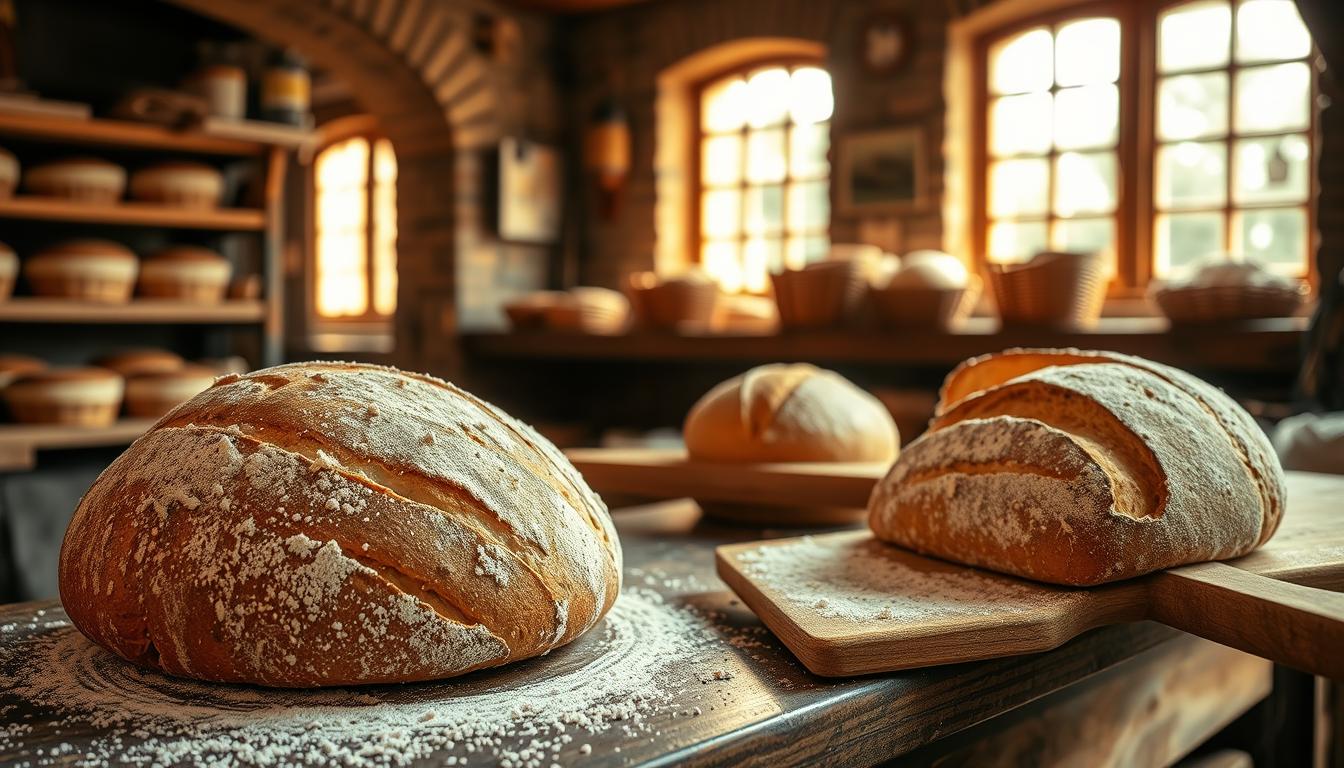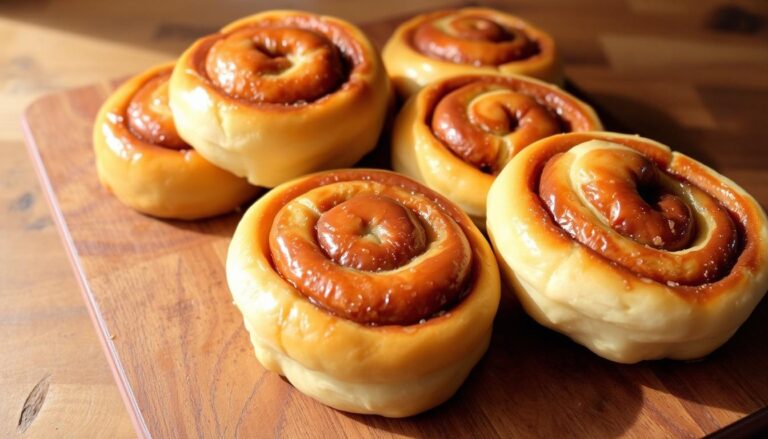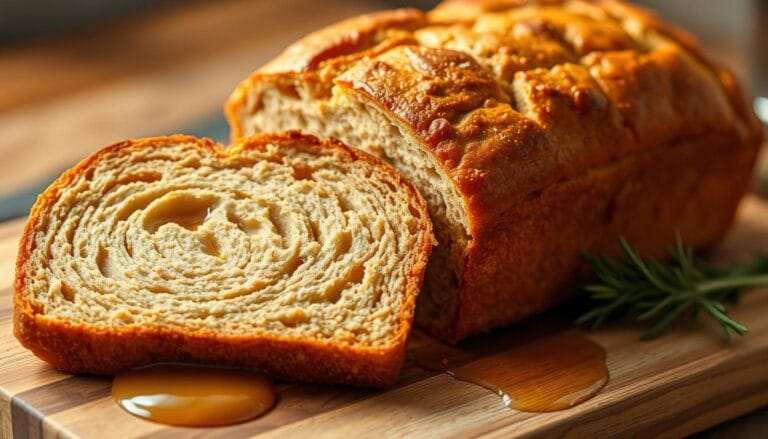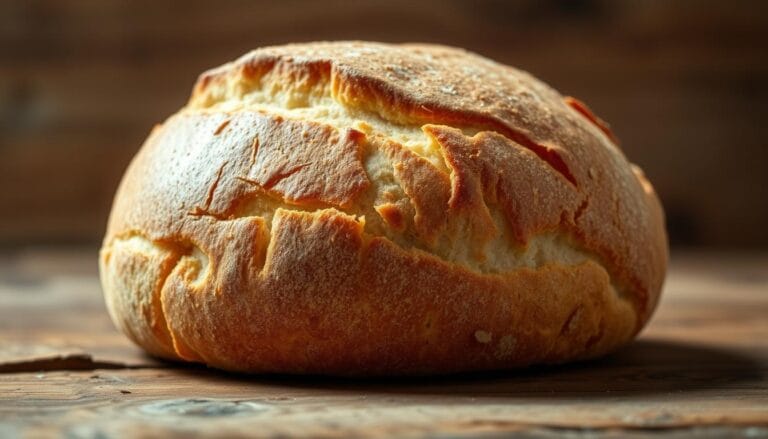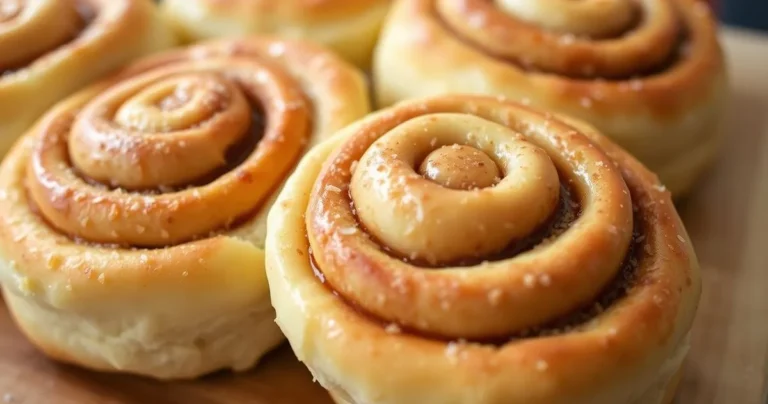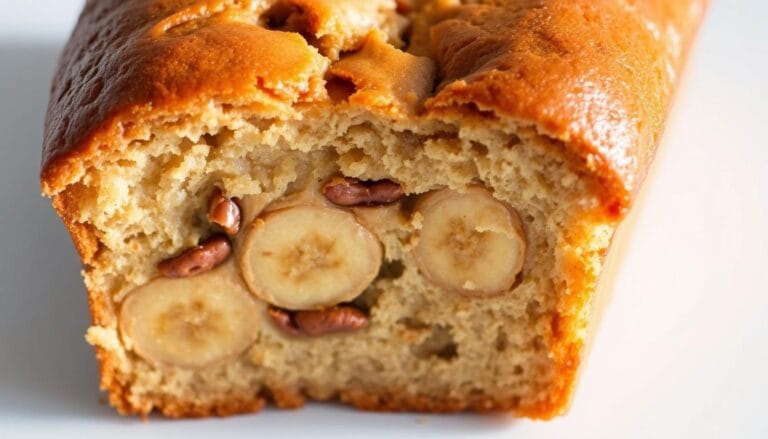French Bread Sourdough – Classic Recipe Archive
The smell of fresh french bread sourdough reminds me of my grandma’s kitchen. Watching her knead dough was magical. It made me want to bake too.
This is your go-to guide for making sourdough bread at home. It’s perfect for both newbies and seasoned bakers. You’ll learn the secrets of French bread making.
Making perfect french bread sourdough is a mix of science, skill, and love. You’ll learn to make a loaf with a crispy outside and soft inside. It’s just like the bread from a fancy bakery.
This guide makes hard steps easy. You’ll learn about choosing the best ingredients and how to ferment. Soon, you’ll be making amazing sourdough bread at home.
Your baking journey begins now. Get ready to dive into French baking traditions. You’ll make something truly special.
Table of Contents
Essential Ingredients for Perfect French Sourdough
To make a great simple sourdough recipe, you need to know the key ingredients. These ingredients turn simple parts into a delicious french bread sourdough. Choosing the right ingredients and knowing their roles is key to success.
Understanding Flour Types and Quality
Flour is the base of your sourdough bread. For a true french bread sourdough, use two main types of flour:
- Unbleached bread flour: It has high protein for great structure
- Whole wheat flour: It adds flavor and nutrition
Experts say to use fresh, high-quality flour. This ensures your sourdough has the best texture and taste.
The Role of Water Temperature
Water might seem simple, but its temperature is very important. Try to keep the water at 80°F (26°C). This helps your sourdough starter work well and makes the dough develop evenly.
Choosing the Right Sourdough Starter
Your sourdough starter is the heart of your bread. Pick a 100% hydration starter that’s active and mature. Look for signs of strong fermentation:
- Doubles in size in 4-8 hours
- Shows consistent bubbling
- Has a nice, tangy smell
By picking the right ingredients and understanding how they work together, you’ll make a sourdough loaf that’s truly special. It will show the true spirit of French baking.
Equipment and Tools You’ll Need
Making perfect simple sourdough bread needs more than skill. It also needs the right tools. Professional bakers say quality equipment makes baking special.
- Dough Rising Bucket with Measurements
- Cast Iron Dutch Oven
- Oval Banneton Proofing Basket
- Sharp Scoring Blade
- Baking Stone
Choosing the right equipment is key. A clear dough rising bucket lets you see how dough grows. A heavy cast iron Dutch oven makes bread crusty and steamy.
| Tool | Purpose | Recommended Brand |
|---|---|---|
| Dough Rising Bucket | Monitor fermentation stages | King Arthur Flour Container |
| Cast Iron Dutch Oven | Create steam and crisp crust | Lodge 5-Quart Dutch Oven |
| Banneton Basket | Shape and proof dough | SUGUS HOUSE Rattan Banneton |
“The right tools are half the battle in creating exceptional sourdough bread.” – Professional Baker’s Wisdom
Invest in good tools to improve your baking. They make making simple sourdough bread easier and more fun.
Preparing Your Sourdough Starter
Creating a sourdough starter is key for any beginner. It’s a mix of wild yeasts and bacteria. They make your sourdough sandwich loaf special.
Your sourdough starter is like a pet. It needs care and attention. It’s not just flour and water. It’s a community that makes your bread special.
Feeding Schedule for Active Starter
A healthy starter needs regular food. Here’s how to feed it:
- Feed your starter at the same time each day
- Use equal parts flour and water by weight
- Discard all but 20 grams of starter before each feeding
- Keep your starter at room temperature (70-75°F)
Signs of a Healthy Starter
Your starter should show these signs:
- Consistent rising and falling after feeding
- Bubbles throughout the mixture
- Pleasant, slightly tangy aroma
- Doubling in volume within 4-8 hours of feeding
“A good starter is like a symphony – every ingredient plays a crucial role in creating something magical.” – Professional Baker
Troubleshooting Common Starter Issues
Don’t worry if your starter is slow. Most problems have easy fixes:
- Slow fermentation? Check your room temperature
- Unusual smell? Increase feeding frequency
- No bubbles? Ensure you’re using fresh, active flour
- Liquid on top? This is normal – simply stir it back in
Getting good at your sourdough starter takes time. Each batch is different. With patience, you’ll learn how to make amazing bread.
French Bread Sourdough: Step-by-Step Mixing Process
Making a tasty simple sourdough recipe needs careful mixing. Your journey starts with mixing ingredients just right.

First, get all your ingredients ready in a big bowl. Knowing how flour, water, and sourdough starter work together is key.
- Combine flour and water first
- Allow initial 30-minute rest for hydration
- Integrate sourdough starter gradually
- Mix until ingredients are fully incorporated
When you mix, aim for a cohesive dough environment. Your sourdough will get strong with the right care and rest.
| Mixing Stage | Duration | Key Action |
|---|---|---|
| Initial Mix | 10-15 minutes | Combine ingredients |
| Autolyse Rest | 30 minutes | Allow flour hydration |
| Starter Integration | 5-10 minutes | Gentle incorporation |
Watch the dough’s feel. A good mix should be smooth and a bit sticky. This means it’s ready for great texture.
“Patience transforms simple ingredients into extraordinary bread.” – Artisan Baker’s Wisdom
Mastering the Stretch and Fold Technique
Learning to make simple sourdough bread starts with the stretch and fold method. This technique makes your bread go from simple to amazing. It builds strength, texture, and flavor in your sourdough.
The stretch and fold method is a big help for home bakers. It’s easier than kneading and helps your dough grow strong. By stretching and folding, you trap gases and get a great crumb.
Timing Your Folds Perfectly
Getting the timing right is key for the stretch and fold method. Here’s a schedule for your simple sourdough bread:
- First fold: 30 minutes after mixing
- Second fold: 45-60 minutes later
- Third fold: Another 45-60 minutes
- Final fold: 45-60 minutes after the third
Building Incredible Dough Strength
Each fold makes your dough stronger. Look for these signs of dough strength:
| Fold Number | Dough Characteristics |
|---|---|
| First Fold | Loose and sticky |
| Second Fold | Slightly more cohesive |
| Third Fold | Smooth and elastic |
| Fourth Fold | Firm and well-structured |
Pro tip: Wet your hands before stretching to avoid sticking. Use a gentle touch to keep the dough from losing air. Your patience will pay off with a fantastic loaf!
Cold Fermentation and Proofing Guide
Cold fermentation makes your french bread sourdough amazing. It’s a slow process that adds rich flavors. It also makes the bread’s texture better by breaking down starches.
Here are the important steps for cold fermentation:
- Temperature control between 38-45°F
- Fermentation duration of 12-24 hours
- Dough development in a sealed container
Your fridge is key for deep flavors in your bread. The cold slows down yeast, making flavors much better.
| Fermentation Stage | Duration | Temperature | Expected Result |
|---|---|---|---|
| Initial Rise | 2-4 hours | Room temperature | Initial dough development |
| Cold Fermentation | 12-24 hours | 38-45°F | Flavor intensification |
| Final Proof | 1-2 hours | Room temperature | Volume expansion |
Look for these signs your bread is ready to bake:
- A slightly puffy texture
- Small bubbles on the surface
- A gentle resistance when pressed
Pro tip: Always let your dough return to room temperature before baking. This ensures the best rise and crust.
Shaping Traditional French Baguettes
Making the perfect french bread sourdough needs skill in baguette shaping. Your simple sourdough recipe turns into a real French bread with the right technique.
Shaping baguettes is a careful process that takes patience and practice. You must be confident and pay close attention to every detail.
Creating the Perfect Baguette Form
To shape your french bread sourdough, follow these steps:
- Divide your fermented dough into equal parts
- Gently stretch each piece into a rectangle
- Fold the edges towards the center, creating tension
- Roll the dough into a long, thin shape
Scoring Patterns and Techniques
Scoring is key in your simple sourdough recipe. It affects both how the bread looks and how it rises. Use a sharp razor or bread lame to make diagonal cuts on the baguette’s surface.
- Make swift, confident cuts at a 45-degree angle
- Space cuts about 1-2 inches apart
- Apply gentle, consistent pressure
Pro tip: Cold dough makes scoring easier and produces cleaner lines.
With practice, you’ll get better at making beautiful, professional-looking french bread sourdough baguettes. They will impress your family and friends.
Baking Methods and Temperature Control

Learning to bake is key for any sourdough bread recipe. Your first step is to understand temperature and technique well.
For a beginner, preheating is very important. Heat your oven to 475°F (245°C). This high heat makes the crust crispy and delicious.
- Preheat your oven with a Dutch oven or baking stone inside
- Aim for consistent high heat around 475°F
- Bake for 20-25 minutes until golden brown
Steam is also very important for the crust. Professional bakers use steam in the first baking phase. You can make steam by:
- Placing a pan of boiling water on the bottom rack
- Spraying water into the oven before placing your dough
- Using a lidded Dutch oven to trap moisture
To check if your bread is done, look for a deep golden color. Also, tap the bottom and listen for a hollow sound. An internal temperature of 205-210°F means it’s perfectly baked.
Remember, patience and practice are key to becoming a sourdough master!
Achieving the Perfect Crust and Crumb
Making great french bread sourdough is all about two things: a crispy outside and a soft inside. Your sourdough sandwich loaf needs the right mix of crust and softness.
Professional bakers use special baking tricks to get the perfect texture. They control heat and moisture to make the bread just right.
Steam Techniques for Crusty Exterior
Steam is key for a crunchy crust on your french bread sourdough. Your baking method is very important. Here are some steam tips:
- Preheat a Dutch oven to create intense steam
- Use a spray bottle to mist water into the oven
- Place a metal pan with water on the bottom rack
- Cover your loaf during initial baking stages
Ideal Internal Temperature
Checking the inside temperature is crucial for a perfectly baked sourdough sandwich loaf. Aim for 190-210°F (88-99°C). A digital thermometer ensures you get it right every time.
Pro tip: Remove your bread from the oven when it reaches 205°F (96°C) for optimal texture and flavor.
Conclusion
Making French sourdough bread is like an art. It needs patience and practice. This simple recipe is a great start for beginners.
Your sourdough journey is about learning from mistakes. You’ll get better with time. Start with the basics and then try new things.
Baking bread connects you to a long tradition. Your kitchen will fill with amazing smells and tastes. Feel free to change things up to make it your own.
With time, you’ll understand how flour, water, and time make magic happen. Keep trying new things and enjoy the process.
FAQ
What type of flour is best for French bread sourdough?
Use high-quality bread flour and whole wheat flour. They give your bread the best texture and taste. This makes your French sourdough rich and complex.
How do I know if my sourdough starter is healthy?
A healthy starter bubbles a lot and grows fast after feeding. It smells good and stays active. If it’s weak or smells bad, it might need more care.
What water temperature is ideal for sourdough fermentation?
The best water temperature is about 80°F. This helps the yeast and bacteria work well. It makes your dough develop flavor and texture.
How often should I feed my sourdough starter?
Feed it daily if you bake often. Store it in the fridge and feed it weekly if you bake less. This keeps it alive with less work.
What equipment do I need to make sourdough bread?
You’ll need a dough bucket, Dutch oven, banneton basket, and a scoring blade. A baking stone is optional. These tools help with rising, steam, shaping, and crust.
How long does cold fermentation take?
Cold fermentation lasts 12 to 36 hours. It makes your bread taste better and easier to handle. This slow process is key to complex flavors.
Can I make sourdough bread without a Dutch oven?
Yes, use a baking stone with steam or a heavy tray. Steam is key for a crispy crust and good rise.
How do I know when my sourdough bread is fully baked?
Check the internal temperature (205-210°F) and the crust color. It should sound hollow when tapped. This means it’s done.
What are stretch and folds, and why are they important?
Stretch and folds help build dough strength without kneading. Do them every 30-45 minutes. They make your bread airy and open.
How can beginners improve their sourdough baking skills?
Practice a lot, keep detailed notes, and try new things. Be patient. Each bake is a chance to learn. Focus on your starter, fermentation, and dough handling.
Your turn: Bake it, Rate it, Share it!
There are no reviews yet. Be the first one to write one.

